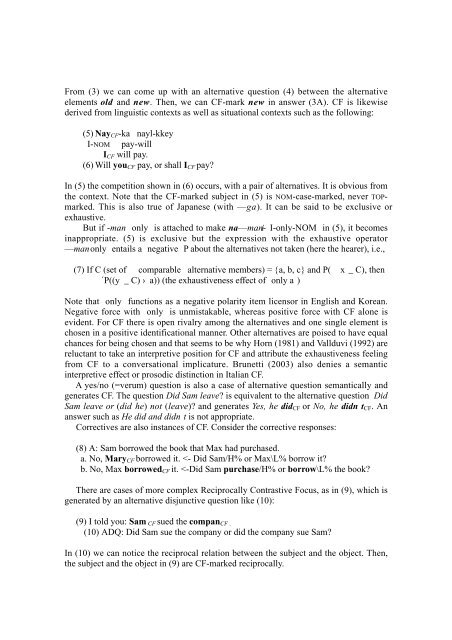SemPrag03.Progr.pdf - Institut für Linguistik/Germanistik - Universität ...
SemPrag03.Progr.pdf - Institut für Linguistik/Germanistik - Universität ...
SemPrag03.Progr.pdf - Institut für Linguistik/Germanistik - Universität ...
You also want an ePaper? Increase the reach of your titles
YUMPU automatically turns print PDFs into web optimized ePapers that Google loves.
From (3) we can come up with an alternative question (4) between the alternative<br />
elements old and new. Then, we can CF-mark new in answer (3A). CF is likewise<br />
derived from linguistic contexts as well as situational contexts such as the following:<br />
(5) Nay CF -ka nayl-kkey<br />
I-NOM pay-will<br />
I CF will pay.<br />
(6) Will you CF pay, or shall I CF pay?<br />
In (5) the competition shown in (6) occurs, with a pair of alternatives. It is obvious from<br />
the context. Note that the CF-marked subject in (5) is NOM-case-marked, never TOPmarked.<br />
This is also true of Japanese (with —ga). It can be said to be exclusive or<br />
exhaustive.<br />
But if -man only is attached to make na—mani<br />
I-only-NOM in (5), it becomes<br />
inappropriate. (5) is exclusive but the expression with the exhaustive operator<br />
—man only entails a negative P about the alternatives not taken (here the hearer), i.e.,<br />
(7) If C (set of comparable alternative members) = {a, b, c} and P( x _ C), then<br />
´P((y _ C) › a)) (the exhaustiveness effect of only a )<br />
Note that only functions as a negative polarity item licensor in English and Korean.<br />
Negative force with only is unmistakable, whereas positive force with CF alone is<br />
evident. For CF there is open rivalry among the alternatives and one single element is<br />
chosen in a positive identificational manner. Other alternatives are poised to have equal<br />
chances for being chosen and that seems to be why Horn (1981) and Vallduvi (1992) are<br />
reluctant to take an interpretive position for CF and attribute the exhaustiveness feeling<br />
from CF to a conversational implicature. Brunetti (2003) also denies a semantic<br />
interpretive effect or prosodic distinction in Italian CF.<br />
A yes/no (=verum) question is also a case of alternative question semantically and<br />
generates CF. The question Did Sam leave? is equivalent to the alternative question Did<br />
Sam leave or (did he) not (leave)? and generates Yes, he did CF or No, he didn t CF . An<br />
answer such as He did and didn t is not appropriate.<br />
Correctives are also instances of CF. Consider the corrective responses:<br />
(8) A: Sam borrowed the book that Max had purchased.<br />
a. No, Mary CF borrowed it.

















